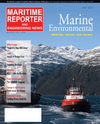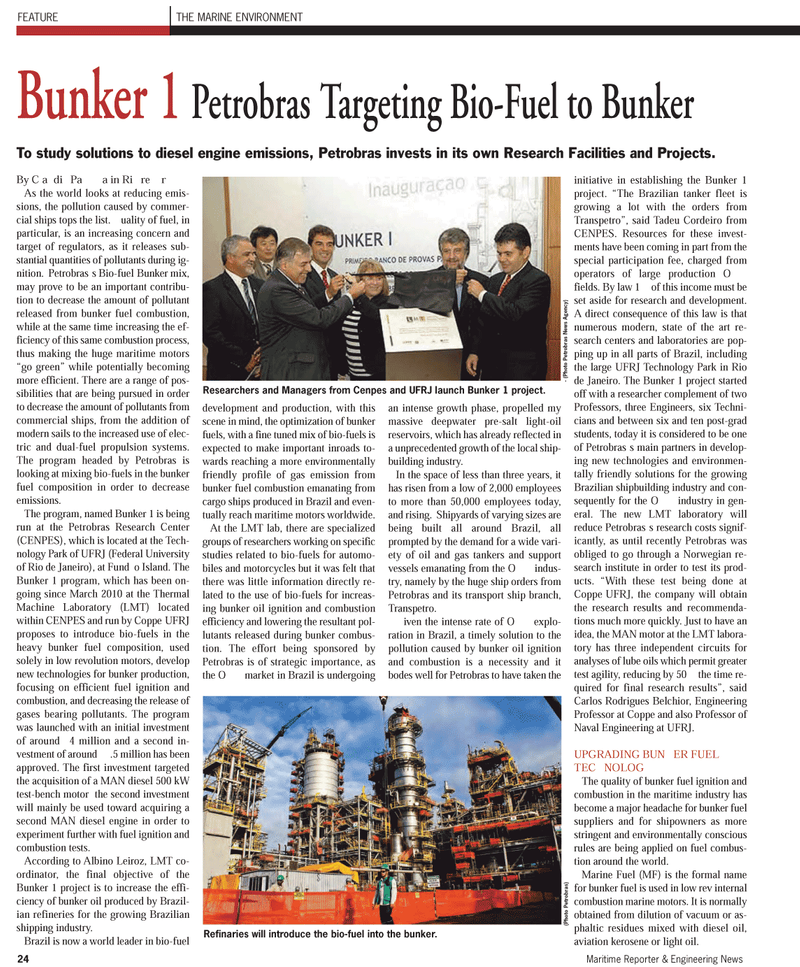
Page 24: of Maritime Reporter Magazine (July 2011)
The Green Ship Edition
Read this page in Pdf, Flash or Html5 edition of July 2011 Maritime Reporter Magazine
24Maritime Reporter & Engineering News By Cadi Paa in Ri rer As the world looks at reducing emis- sions, the pollution caused by commer- cial ships tops the list. uality of fuel, in particular, is an increasing concern and target of regulators, as it releases sub- stantial quantities of pollutants during ig-nition. Petrobrass Bio-fuelBunker mix, may prove to be an important contribu- tion to decrease the amount of pollutantreleased from bunker fuel combustion, while at the same time increasing the ef-ficiency of this same combustion process, thus making the huge maritime motors?go green? while potentially becomingmore efficient. There are a range of pos- sibilities that are being pursued in orderto decrease the amount of pollutants fromcommercial ships, from the addition ofmodern sails to the increased use of elec-tric and dual-fuel propulsion systems.The program headed by Petrobras islooking at mixing bio-fuels in the bunker fuel composition in order to decreaseemissions.The program, named Bunker 1 is being run at the Petrobras Research Center(CENPES), which is located at the Tech- nology Park of UFRJ (Federal University of Rio de Janeiro), at Fundo Island. The Bunker 1 program, which has been on- going since March 2010 at the Thermal Machine Laboratory (LMT) locatedwithin CENPES and run by CoppeUFRJ proposes to introduce bio-fuels in theheavy bunker fuel composition, used solely in low revolution motors, develop new technologies for bunker production, focusing on efficient fuel ignition and combustion, and decreasing the release of gases bearing pollutants. The program was launched with an initial investment of around 4 million and a second in- vestment of around .5 million has been approved. The first investment targeted the acquisition of a MAN diesel 500 kWtest-bench motor the second investment will mainly be used toward acquiring a second MAN diesel engine in order toexperiment further with fuel ignition and combustion tests. According to Albino Leiroz, LMT co- ordinator, the final objective of the Bunker 1 project is to increase the effi- ciency of bunker oil produced by Brazil- ian refineries for the growing Brazilian shipping industry. Brazil is now a world leader in bio-fuel development and production, with this scene in mind, the optimization of bunker fuels, with a fine tuned mix of bio-fuels is expected to make important inroads to- wards reaching a more environmentally friendly profile of gas emission from bunker fuel combustion emanating from cargo ships produced in Brazil and even- tually reach maritime motors worldwide. At the LMT lab, there are specializedgroups of researchers working on specific studies related to bio-fuels for automo-biles and motorcycles but it was felt that there was little information directly re- lated to the use of bio-fuels for increas-ing bunker oil ignition and combustion efficiency and lowering the resultant pol- lutants released during bunker combus- tion. The effort being sponsored by Petrobras is of strategic importance, as the O market in Brazil is undergoing an intense growth phase, propelled my massive deepwater pre-salt light-oil reservoirs, which has already reflected in a unprecedented growth of the local ship- building industry. In the space of less than three years, ithas risen from a low of 2,000 employees to more than 50,000 employees today, and rising. Shipyards of varying sizes are being built all around Brazil, all prompted by the demand for a wide vari- ety of oil and gas tankers and support vessels emanating from the O indus- try, namely by the huge ship orders from Petrobras and its transport ship branch,Transpetro. iven the intense rate of O explo- ration in Brazil, a timely solution to thepollution caused by bunker oil ignition and combustion is a necessity and it bodes well for Petrobras to have taken the initiative in establishing the Bunker 1 project. ?The Brazilian tanker fleet is growing a lot with the orders from Transpetro?, said Tadeu Cordeiro from CENPES. Resources for these invest- ments have been coming in part from the special participation fee, charged from operators of large production O fields. By law 1 of this income must be set aside for research and development. A direct consequence of this law is that numerous modern, state of the art re-search centers and laboratories are pop-ping up in all parts of Brazil, includingthe large UFRJ Technology Park in Rio de Janeiro. The Bunker 1 project started off with a researcher complement of two Professors, three Engineers, six Techni- cians and between six and ten post-gradstudents, today it is considered to be oneof Petrobrass main partners in develop- ing new technologies and environmen- tally friendly solutions for the growing Brazilian shipbuilding industry and con- sequently for the O industry in gen- eral. The new LMT laboratory will reduce Petrobrass research costs signif- icantly, as until recently Petrobras was obliged to go through a Norwegian re- search institute in order to test its prod-ucts. ?With these test being done at CoppeUFRJ, the company will obtain the research results and recommenda-tions much more quickly. Just to have an idea, the MAN motor at the LMT labora-tory has three independent circuits foranalyses of lube oils which permit greatertest agility, reducing by 50 the time re- quired for final research results?, said Carlos Rodrigues Belchior, Engineering Professor at Coppe and also Professor ofNaval Engineering at UFRJ. UPGRADING BUNER FUEL TECNOLOG The quality of bunker fuel ignition and combustion in the maritime industry has become a major headache for bunker fuel suppliers and for shipowners as more stringent and environmentally conscious rules are being applied on fuel combus- tion around the world. Marine Fuel (MF) is the formal namefor bunker fuel is used in low rev internal combustion marine motors. It is normally obtained from dilution of vacuum or as- phaltic residues mixed with diesel oil, aviation kerosene or light oil. THE MARINE ENVIRONMENTFEATURE Bunker 1 Petrobras Targeting Bio-Fuel to Bunker To study solutions to diesel engine emissions, Petrobras invests in its own Research Facilities and Projects. Researchers and Managers from Cenpes and UFRJ launch Bunker 1 project. - (Photo Petrobras News Agency) Refinaries will introduce the bio-fuel into the bunker. (Photo Petrobras)

 23
23

 25
25
